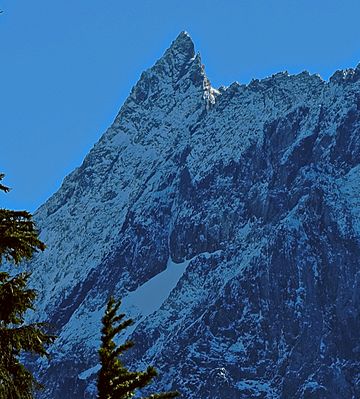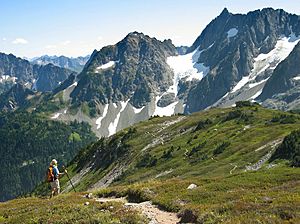Magic Mountain (Washington) facts for kids
Quick facts for kids Magic Mountain |
|
|---|---|

The sharp summit of Magic Mountain
|
|
| Highest point | |
| Elevation | 7,610 ft (2,320 m) |
| Prominence | 530 ft (160 m) |
| Isolation | 0.86 mi (1.38 km) |
| Parent peak | Hurry-up Peak (7,821 ft) |
| Geography | |
| Location | Skagit County, Washington, U.S. |
| Parent range | North Cascades Cascade Range |
| Topo map | USGS Cascade Pass |
| Type of rock | Magic Mountain Gneiss |
| Climbing | |
| First ascent | 1938, Calder Bressler, Ralph Clough, Bill Cox, Tom Myers |
| Easiest route | scrambling + glacier travel |
Magic Mountain is a tall mountain peak in Washington state. It stands about 7,610 feet (2,319 meters) high. You can find it where Skagit County and Chelan County meet. This mountain is part of the amazing North Cascades Range, which is a smaller part of the larger Cascade Range.
Magic Mountain is located southeast of a place called Cascade Pass. It sits right on the edge of North Cascades National Park and Glacier Peak Wilderness. Close by, about 0.4 miles (0.6 km) to the northeast, is Pelton Peak. The highest peak nearby is Hurry-up Peak, about 0.83 miles (1.3 km) to the south. Two large ice fields, the Yawning Glacier and Cache Col Glacier, are found on its northern side. Magic Mountain is also at the northern end of a famous hiking route called the Ptarmigan Traverse. Water from the north side of the mountain flows into the Stehekin River. Water from the southwest side drains into the Cascade River.
Mountain Climate
Magic Mountain is in a special marine west coast climate zone. This means it's near the ocean, which affects its weather. Most of the weather systems start over the Pacific Ocean. They then travel northeast towards the Cascade Mountains.
As these weather systems reach the North Cascades, the tall peaks force the air upwards. This causes the air to cool down and drop its moisture. This moisture falls as rain or snowfall onto the mountains. This process is called Orographic lift. Because of this, the western side of the North Cascades gets a lot of rain and snow, especially in winter.
In winter, the weather is often cloudy. But in summer, high-pressure systems over the Pacific Ocean bring clear skies. The ocean's influence makes the snow wet and heavy. This can lead to a high risk of avalanches, which are dangerous slides of snow.
Mountain Geology
The North Cascades area has some of the most rugged landforms in the Cascade Range. You can see sharp peaks, rocky ridges, deep valleys carved by glaciers, and tall granite spires. These amazing landscapes were formed by geological events that happened millions of years ago. These events created huge changes in height across the Cascade Range.
The story of how the Cascade Mountains formed began millions of years ago. This was during the late Eocene Epoch. At that time, the North American Plate was slowly moving over the Pacific Plate. This movement caused many periods of volcanic activity, creating new rocks. Also, small pieces of the Earth's crust, called terranes, came together. These pieces helped form the North Cascades about 50 million years ago.
Later, during the Pleistocene period, which started over two million years ago, huge sheets of ice called glaciers moved across the land. These glaciers advanced and then melted away many times. As they moved, they scraped and shaped the landscape. They left behind piles of rock debris. The "U"-shaped valleys you see today were carved out by these glaciers. The combination of land uplift (when land rises) and faulting (when cracks form in the Earth's crust) along with glaciation has created the tall peaks and deep valleys of the North Cascades.




